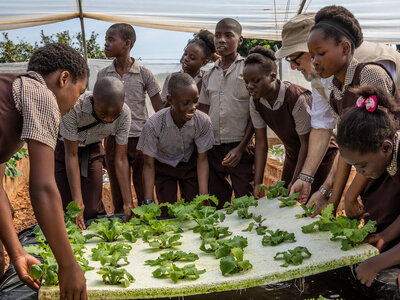Zambia
- 35%
- of people unable to meet their minimum-calorie requirements
- 32%
- of children are stunted (impaired development due to malnutrition)
- 19.6 million
- population
More than half of Zambia's population still lives below the poverty line. The COVID-19 pandemic put further strain on an economy already weakened by recurrent climate shocks, falling copper prices and unsustainable fiscal policies.
The country is recovering from its worst drought on record in 2023-2024, induced by El Niño, during which some regions received less than 50 percent of usual annual rainfall. The drought affected food production and natural resources, with a knock-on effect on food security.
Zambia’s 2 million smallholder farmers are extremely vulnerable to such climate shocks, as they predominately depend on rain-fed agriculture. They also face limited access to high-quality inputs, climate and post-harvest management information, sustainable markets and financial services.
Malnutrition rates remain among the highest in the world, with 35 percent of the population unable to meet their minimum-calorie requirements and more than one-third of children aged under 5 stunted. Limited knowledge of nutrition, lack of access to diverse nutritious food, poor feeding practices and poor-quality diets are major factors. Overweight and obesity, especially among women, is a growing problem attributed to high consumption of unhealthy diets.
Zambia currently hosts over 82,000 refugees and asylum seekers. Most refugees (80 percent) are women and children fleeing conflict in the Democratic Republic of the Congo, who require humanitarian assistance to survive.
The World Food Programme (WFP) drives innovation and positive change in disaster risk management, smallholder farmer support, school meals and social protection. WFP is focusing its efforts on strengthening national systems and capacities.
What the World Food Programme is doing in Zambia
-
Crisis response
-
WFP helps food-insecure people meet their basic food and nutrition needs. Cash and food assistance is provided to refugees from the Democratic Republic of the Congo based in Mantapala Refugee Settlement, as well as vulnerable people affected by climate and other shocks. Cash allows people to buy the food they prefer, and can contribute towards more diverse diets.
-
Nutrition
-
Smallholder farmer support
-
Strengthening government social protection systems
-
Service provision
Zambia news releases
Go to pagePartners and Donors
View allFind out more about the state of food security in Zambia
Visit the food security analysis pageOperations in Zambia
Contacts
Office
Plot 10/4971, Tito Road, Rhodes Park, Lusaka, Zambia, P.O. Box 37726
Lusaka
Zambia






